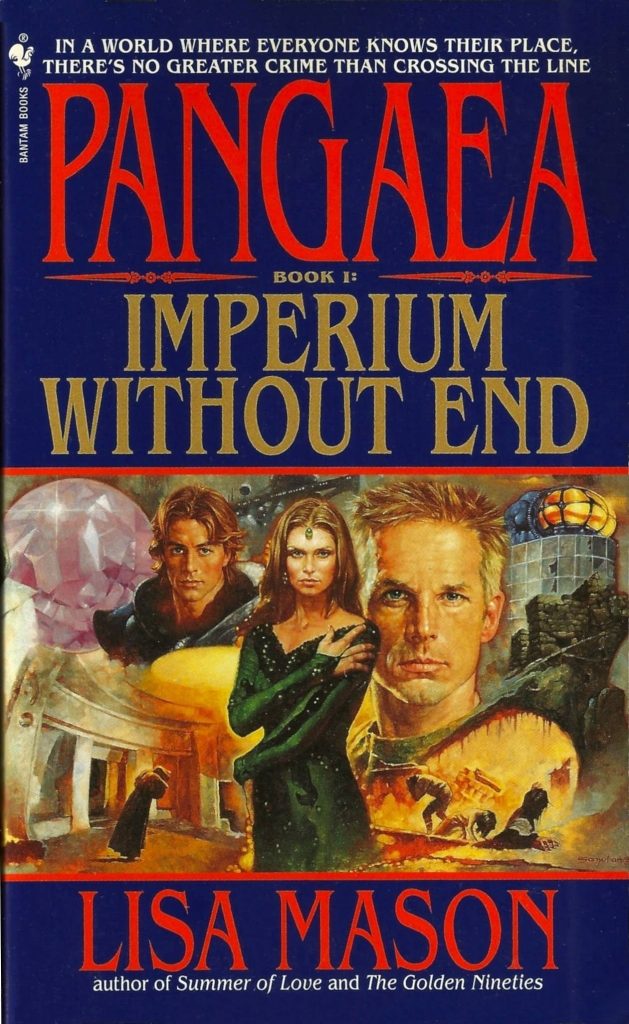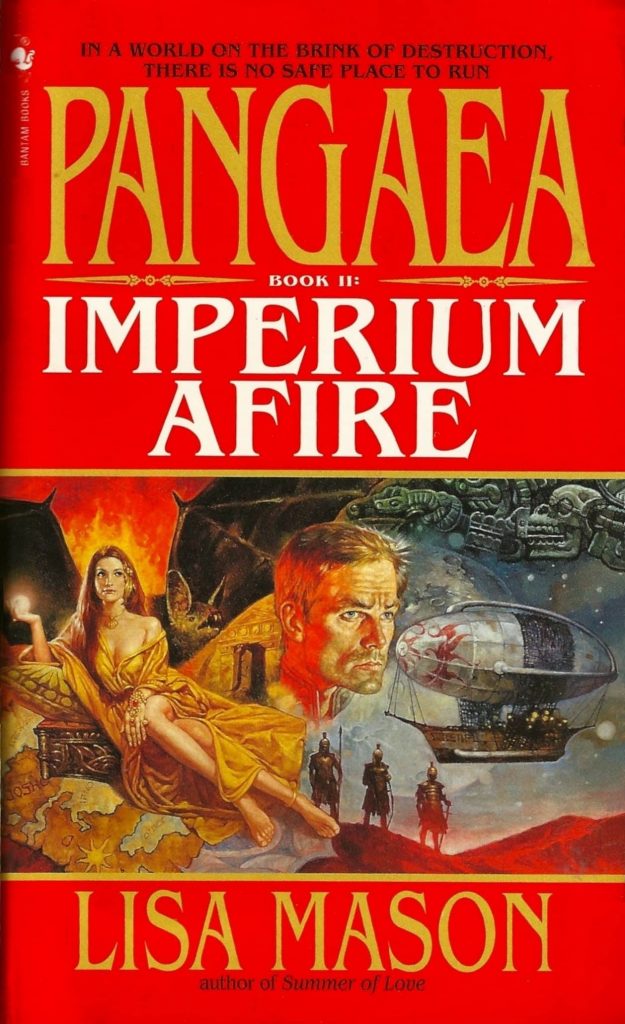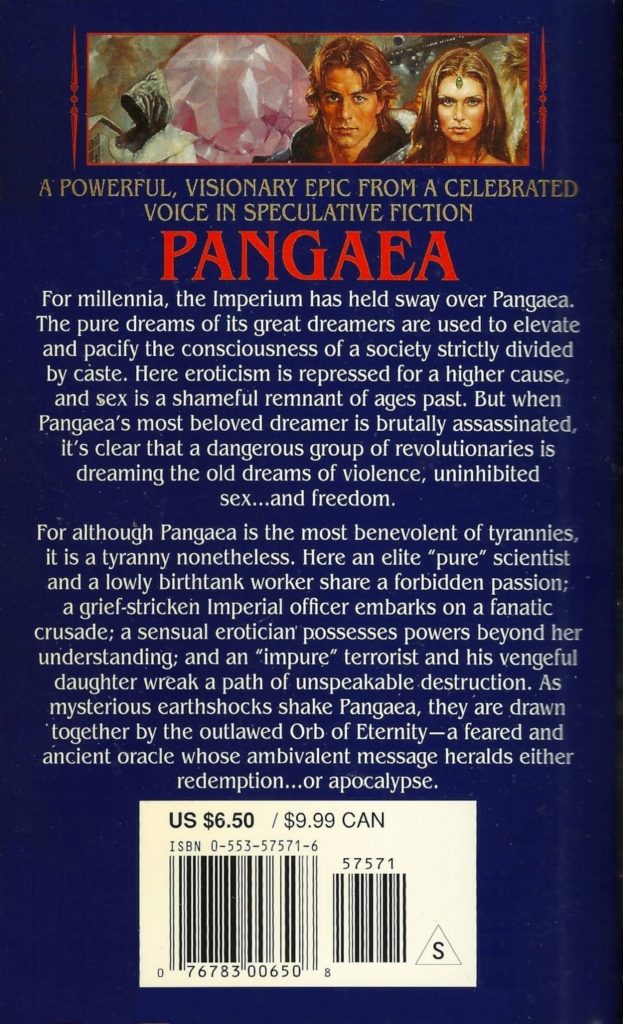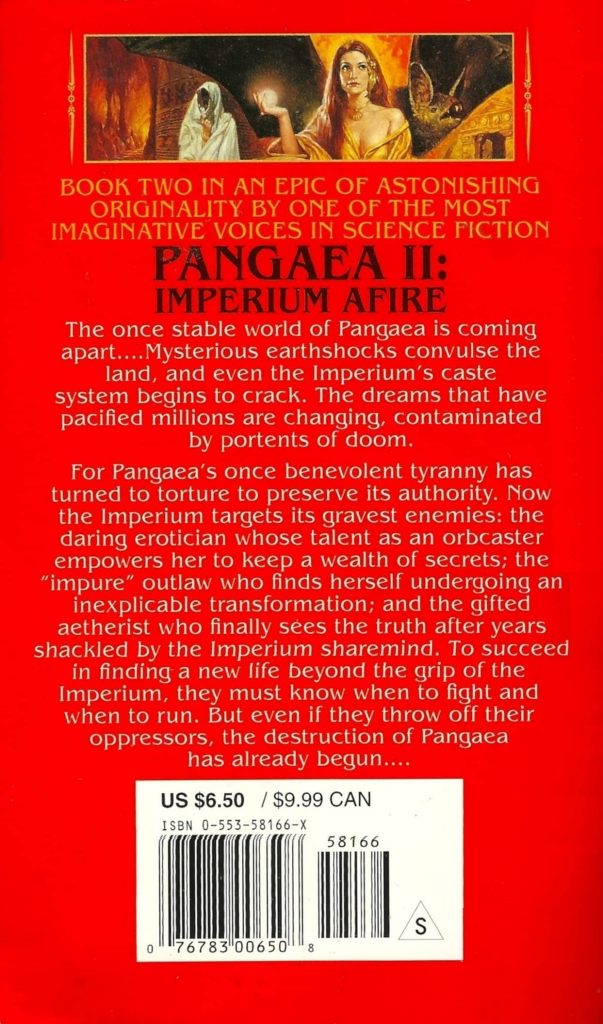Vintage Treasures: The Pangaea Series by Lisa Mason
The Pangaea volumes: Imperium Without End and Imperium Afire
(Bantam Spectra, 1999 and 2000). Covers by Sanjulian
Lisa Mason began her career in the late 80s; her first novel was the cyberpunk Arachne (1990), set in an earthquake-devastated San Francisco. Her most popular title, Summer of Love (1994), about a time traveler from 2467 who visits the 1967 Summer of Love in San Francisco, was a finalist for the Philip K. Dick Award and spawned one sequel, The Golden Nineties (1995).
We’re concerned today with perhaps her most ambitious series, the two-volume Pangaea cycle set on a distant world (which — spoiler — turns out to be an alternate history version of San Francisco) where people live and work in a rigid society strictly segregated by genetic purity. Here’s John Clute’s summary from The Encyclopedia of Science Fiction.
Mason’s third series, the Pangaea sequence comprising Pangaea, Book 1: Imperium Without End (1999) and Pangaea, Book 2: Imperium Afire (2000), combines some of the complex interweavings of her first series with the “soft” focus on character that marks her second. Set in an Alternate History version of San Francisco, somewhere fairly deep in the future, the series gradually unveils a punitively Dystopian government, with regimented Sex and a rigid caste system. In the second volume, all falls apart (see End of the World), without a clear resolution.
The Pangaea novels didn’t get a lot of attention when they were first released; vanishing without a trace into the crowded SF bookshelves of the mid-90s. They have never been reprinted, and there isn’t even a digital edition.
Back covers to Pangaea: Imperium Without End and Imperium Afire
I’ve always been curious about them, however. Lisa Mason is a fine writer, and these books are both a significant departure from her other writing, and an important component of her expansive vision of the future of California. The evocative cover paintings by the brilliant artist Sanjulian don’t hurt either.
Black Gate reviewer Charlene Brusso published a detailed review of the first novel at SF Site in 1999; here’s the highlights.
Pangaea considers itself a civilized world which thrives on order, reined in and stabilized over the millennia by the laws of the all-powerful Imperium. Society is divided into rigid castes denoted by genetic purity. At the bottom of the pyramid are the lowly druds charged with society’s grunt work: sanitation, farm and factory labour. Those less impure form the merchant class, technicians trained to handle the harvesting and care of “Imperial materia,” sperm and ova harvested from each citizen at the onset of puberty and stored in secure laboratories. There they stay in absolute pure safety, until the day of holy sharelock, the lawful joining of a couple in mind and spirit, after which they may petition to have children — which are, of course, duly conceived in vitro and lab-raised for the nine months before actual birth.
The pures are the most educated, wealthiest, most powerful members of Pangaea’s society — second only to the rare, solitary Angels, those whose crystalline purity and skillful “sharemind” abilities allow them to project the wonderful dreams which entertain and titillate those lesser members of society. As far as the pures are concerned, the only instability within Pangaea is the random, dangerous quaking of the earth, a threat which top scientists work to predict and someday hope to alleviate, or even prevent….
The novel opens with Lucyd, an angel and one of the most beloved dreamers in the land, who’s barely begun to mourn the loss of his sharemate/wife Danti, recently murdered by a terrorist explosion. In the midst of his sorrow (as well as disquiet over the dark symbols of his latest dream), comes the ringing of the great Bell, warning of an impending earthquake.
From there we jump to Plaia, a researcher of quakes and resonance theory, in the thick of the geologic upheaval…. Plaia briefly makes eye contact with a sexy young guy on the street. That young man is Dubban, a technician in one of the natalries where babies are made on Pangaea, and he doesn’t forget Plaia’s face either, as he suffers through the next work day….
Despite the large cast of characters, Mason balances the plotlines with skill. The world is intriguing and the characters are well-drawn… Mason’s previous books (the revisionist 60s fantasy novel Summer of Love and the lively fin de siècle The Golden Nineties) are enough reason to give the next in the series a try.
Here’s the publishing details.
Pangaea: Imperium Without End (Bantam Spectra, 392 pages, $6.50 in paperback, May 1999) — cover by Sanjulian
Pangaea: Imperium Afire (Bantam Spectra, 378 pages, $6.50 in paperback, May 2000) — cover by Sanjulian
See all our recent Vintage Treasures here.



